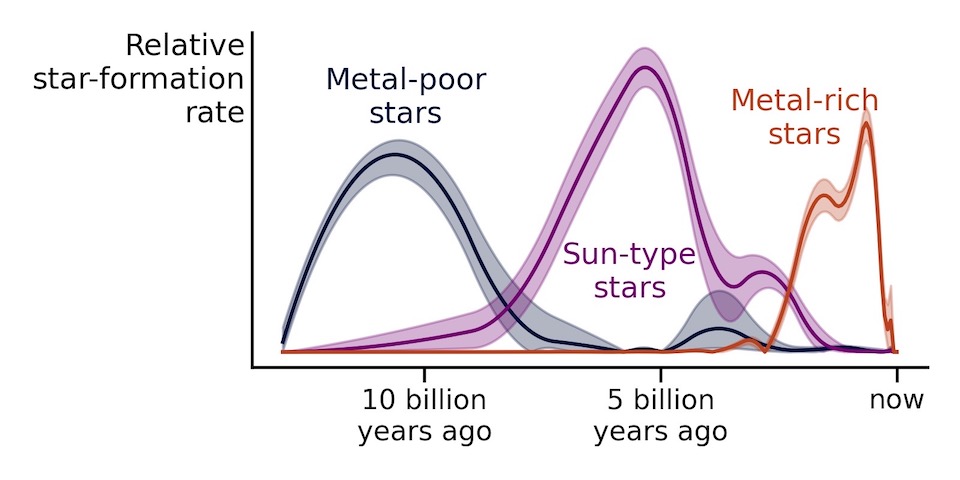What caused our Sun to be born? A recent paper by researchers from the Instituto de Radioastronomía y Astrofísica (IRyA) suggests that the answer may lie in a small satellite galaxy that is slowly being devoured by our larger Milky Way Galaxy.
The smaller galaxy (known as the Sagittarius Dwarf Spheroidal Galaxy, or Sgr dSph) is on an elongated orbit around the Milky Way, making a close approach every billion years or so. Every time it does so, it shakes up the gas clouds in the Milky Way's disk, which encourages the birth of new stars. One such burst of star formation, which occurred about 5 billion years ago is likely to have included the birth of our Sun.
Researchers led by the doctoral student Jairo Alzate obtained the brightness and colors of more than 100,000 nearby stars in the solar neighborhood from observations with the Gaia satellite, which was launched by the European Space Agency in 2013. In a paper published last year [1] in the international journal Monthly Notices of the Royal Astronomical Society, they used these measurements to reconstruct the historical record of star births in the small region of the Milky Way within about 300 light years of the Sun. By looking at groups of stars with different chemical compositions (see box), they were able to identify 3 different epochs of star formation, as shown in the Figure.

Metallicity
The fraction of heavy elements such as carbon, oxygen, and iron in the chemical make-up of a star is known as its metallicity. The earliest generations of stars are relatively poor in metals, since only light elements such as hydrogen and helium were created in the Big Bang at the beginning of the Universe (about 14 billion years ago). Each generation of stars converts some hydrogen into heavier elements and a fraction of these are expelled from the stars to mix with the Galactic gas clouds from which the next generation will be born. This is why the metallicity of newborn stars tends to increase with time over the lifetime of a galaxy such as ours.
Alzate and colleagues found that the metal-poor stars show a peak in their birth rate about 10 billion years ago, which declines to much lower levels by 8 billion years ago. For stars with a similar composition to the Sun, on the other hand, the birth rate has a peak from 4 to 6 billion years ago. This agrees very well with the age of our Sun, which is known to be about 4.5 billion years. Stars with an even higher metallicity than our Sun continue being formed until relatively recently, but at a much lower rate than in the previous bursts.
This result is consistent with other independent studies that have used different methods. For instance, researchers from Spain, France and Italy, led by Tomás Ruiz-Lara from Tenerife, also found evidence for a burst around 6 billion years ago, together with more recent bursts at 2 and 1 billion years ago [2]. On the other hand, another recent study by researchers from Italy, Chile, and China, led by Piero Dal Tio from Padua, detected a low-metallicity burst 9.5 billion years ago but found no evidence for any more recent bursts [3]. Clearly, further study is needed to resolve these differences.
The Sagittarius Dwarf Spheroidal Galaxy is currently less massive than the Milky Way by a factor of more than 1000, but astronomers believe it was much more massive in the past. Tidal forces due to its interaction with the Milky Way are gradually stripping its stars away and it is likely to have dissipated completely within the next billion years. In the meantime, its close passages through the Milky Way are causing several different ripple effects. In addition to the bursts of star formation identified by Alzate and colleagues, peculiar patterns of correlation between star speeds and positions (known as phase-space spirals and ridges) have recently been detected in the solar neighborhood, and these too have been attributed to the Sagittarius Dwarf [4]. It has even been suggested that the spiral arms of the Milky Way might owe their formation to long-ago interactions with the Sagittarius Dwarf at a time when that galaxy was more massive [5].
Author: William Henney, Instituto de Radioastronomía y Astrofísica, UNAM, Campus Morelia. Email:
References
- Featured Paper: Alzate J. A., Bruzual G., Díaz-González D. J., Star formation history of the solar neighbourhood as told by Gaia. Monthly Notices of the Royal Astronomical Society, 501, 302-328 (2021).

- Ruiz-Lara T., Gallart, C., Bernard, E. J., Cassisi, S., Nature Astronomy, 4, 965-973 (2020).

- Dal Tio, P., and 8 colleagues, Monthly Notices of the Royal Astronomical Society, 506, 5681-5697 (2021).

- Antoja, T., and 12 colleagues, Nature, 561, 360-362 (2018).

- Purcell, C. W., Bullock, J. S., Tollerud, E. J., Rocha, M., Chakrabarti, S., Nature, 477, 301-303 (2011).

Additional Information
- Jairo Alzate received his PhD in Astrophysics at IRyA, UNAM in January 2021.
- Gustavo Bruzual is a researcher at IRyA, UNAM.
- Daniel Díaz-González is a doctoral student at IRyA, UNAM.
Text and images copyright William Henney 2022. This work is licensed under CC BY 4.0




